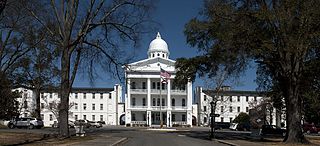
Bryce Hospital opened in 1861 in Tuscaloosa, Alabama, United States. It is Alabama's oldest and largest inpatient psychiatric facility. First known as the Alabama State Hospital for the Insane and later as the Alabama Insane Hospital, the building is considered an architectural model. The hospital currently houses 268 beds for acute care, treatment and rehabilitation of full-time (committed) patients. The Mary Starke Harper Geriatric Psychiatry Hospital, a separate facility on the same campus, provides an additional 100 beds for inpatient geriatric care. The main facility was added to the National Register of Historic Places in 1977.
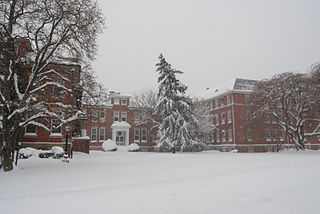
The Crownsville Hospital Center was a psychiatric hospital located in Crownsville, Maryland. It was in operation from 1911 until 2004.

Oregon State Hospital is a public psychiatric hospital in the U.S. state of Oregon, located in the state's capital city of Salem with a smaller satellite campus in Junction City opened in 2014. Founded in 1862 and constructed in the Kirkbride Plan design in 1883, it is the oldest operating psychiatric hospital in the state of Oregon, and one of the oldest continuously operated hospitals on the West Coast.

Georgia's state mental asylum located in Milledgeville, Georgia, now known as the Central State Hospital (CSH), has been the state's largest facility for treatment of mental illness and developmental disabilities. In continuous operation since accepting its first patient in December 1842, the hospital was founded as the Georgia State Lunatic, Idiot, and Epileptic Asylum, and was also known as the Georgia State Sanitarium and Milledgeville State Hospital during its long history. By the 1960s the facility had grown into the largest mental hospital in the world. Its landmark Powell Building and the vast, abandoned 1929 Jones Building stand among some 200 buildings on two thousand acres that once housed nearly 12,000 patients.
Central State Hospital is a 192-bed adult psychiatric hospital located in the Lakeland neighborhood of Louisville, Kentucky. In 1869, 200 acres were purchased by the Kentucky State Legislature from the descendants of renown frontiersman Issac Hite to establish a "State House of Reform for Juvenile Delinquents." This was located on the outskirts of what would become Anchorage, Kentucky. In 1873, due to overcrowding at both of Kentucky's mental hospitals, the House of Reform was converted into the Fourth Kentucky Lunatic Asylum, with Dr. C.C. Forbes as its first Superintendent. The following year an act of the legislature renamed it the Central Kentucky Lunatic Asylum. In late 1887, it received its own post office, called simply "Asylum". The following year its name was changed to "Lakeland", and the institution was commonly referred to as "Lakeland Hospital" or "Lakeland Asylum". By 1900, its official name had been changed to the Central Kentucky Asylum for the Insane. By 1912 it was known as Central State Hospital. Comparable institutions are Eastern State Hospital at Lexington in Fayette County and Western State Hospital at Hopkinsville, Christian County, Kentucky. All three were administered by the Board of Charitable Organizations.

Peoria State Hospital Historic District, also known as Bartonville State Hospital or Illinois Asylum for the Incurable Insane, was a psychiatric hospital operated by the State of Illinois from 1902 to 1973. The hospital is located in Bartonville, Illinois, near the city of Peoria in Peoria County. The hospital grounds and its 63 buildings are listed as a historic district on the National Register of Historic Places.

The Trans-Allegheny Lunatic Asylum, subsequently the Weston State Hospital, was a Kirkbride psychiatric hospital that was operated from 1864 until 1994 by the government of the U.S. state of West Virginia, in the city of Weston. Weston State Hospital got its name in 1913 which was used while patients occupied it, but was changed back to its originally commissioned, unused name, the Trans-Allegheny Lunatic Asylum, after being reopened as a tourist attraction.
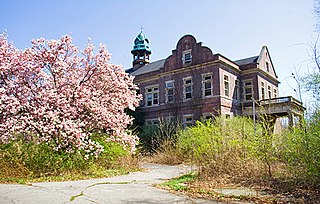
Pennhurst State School and Hospital, originally known as the Eastern Pennsylvania State Institution for the Feeble-Minded and Epileptic was a state-run institution for mentally and physically disabled individuals of Southeastern Pennsylvania located in Spring City. After 79 years of controversy, it closed on December 9, 1987.
Mendota Mental Health Institute (MMHI) is a public psychiatric hospital in Madison, Wisconsin, United States, operated by the Wisconsin Department of Health Services. The hospital is accredited by the Joint Commission. Portions of the facility are included in the Wisconsin Memorial Hospital Historic District, District #88002183. The Mendota State Hospital Mound Group and Farwell's Point Mound Group are also located at the facility.

The North Dakota State Hospital, on the southern rim of the James River valley overlooking Jamestown, North Dakota, has since 1885 been North Dakota's primary institution for treating the mentally ill and confining the criminally insane.
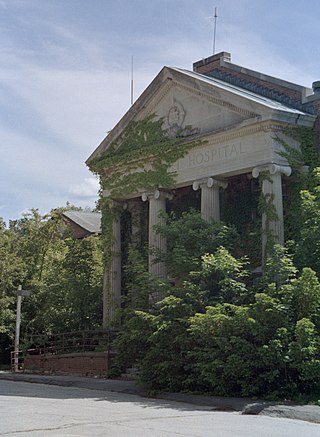
The Mansfield Training School and Hospital was a state school for people with developmental disabilities located in Mansfield, Connecticut, United States. It was active from 1860 to 1993. Its former campus, located at the junction of Connecticut Route 32 and United States Route 44 in Mansfield is a 350-acre (140 ha) historic district that was listed on the National Register of Historic Places in 1987.

The Fairview Training Center was a state-run facility for people with developmental disabilities in Salem, Oregon, United States. Fairview was established in 1907 as the State Institution for the Feeble-Minded. The hospital opened on December 1, 1908, with 39 patients transferred from the Oregon State Hospital for the Insane. Before its closure in 2000, Fairview was administered by the Oregon Department of Human Services (DHS). DHS continued to operate the Eastern Oregon State Hospital in Pendleton until October 31, 2009.

The North Princeton Developmental Center, formerly known as the New Jersey State Village for Epileptics, was a medical facility within Montgomery Township, Somerset County, New Jersey. The facility was home to a variety of mental health institutions throughout the years. In 2011, the former self-sustaining mental health village was slated for demolition to make space for a proposed county park. Demolition was completed in 2012 with plans to begin construction of the conceptual park in 2013. The facility garnered much notoriety over the past decades due to its "ghost town" appearance and mention in the popular book and periodical, "Weird N.J." Until its demolition, the former hospital was a popular place for "urban explorers" to explore, despite the buildings being unsafe (partially due to asbestos and lead paint contamination. Urban explorers were often met with resistance from law enforcement, as the site was prone to criminal activity, ranging from graffiti to arson. Prior to the demolition of the site, state and local governments have both made reasonable attempts to keep trespassers out, for example by sealing the entrances and windows of the property, though these methods proved to be relatively ineffective.
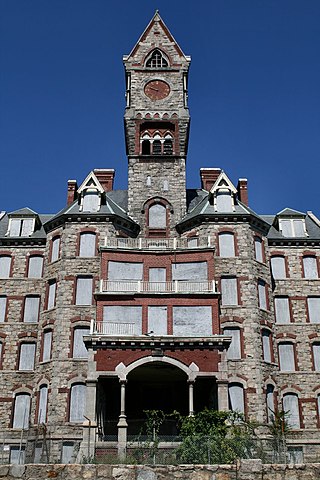
Worcester State Hospital was a Massachusetts state mental hospital located in Worcester, Massachusetts. It is credited to the architectural firm of Weston & Rand. The hospital and surrounding associated historic structures are listed as Worcester Asylum and related buildings on the National Register of Historic Places.

Winnebago Mental Health Institute (WMHI), formerly the Winnebago State Hospital, is a psychiatric hospital near Oshkosh, Wisconsin, United States located in the unincorporated community of Winnebago, Wisconsin.
The Clarinda Treatment Complex was built in 1884 as the Clarinda State Hospital in Clarinda, Iowa in southwest Iowa. It was the third asylum in the state of Iowa. The hospital's many name variations include: The Clarinda Lunatic Asylum, The Clarinda State Asylum, The Clarinda Asylum for the Insane, and The Clarinda Mental Health Institute. It was built under the Kirkbride Plan. The original plan for patients was to hold alcoholics, geriatrics, drug addicts, mentally ill, and the criminally insane. In 2009, it was made public that, to save money, the state may close one of the four hospitals in Iowa. On June 30, 2015, the hospital facility was shut down and all patient services terminated. The Clarinda Academy, owned by Sequel Youth Services, is the sole occupant of the former hospital grounds.

The Fergus Falls Regional Treatment Center is a former hospital located in Fergus Falls, Minnesota. It was built in the Kirkbride Plan style and first opened to patients in 1890. Over the next century it operated as one of the state's main hospitals for the mentally ill and also worked with people with developmental disabilities and chemical dependency issues. It was added to the National Register of Historic Places in 1986.

Vermont State Hospital, alternately known as the Vermont State Asylum for the Insane and the Waterbury Asylum, was a mental institution built in 1890 in Waterbury, Vermont to help relieve overcrowding at the privately run Vermont Asylum for the Insane in Brattleboro, Vermont, now known as the Brattleboro Retreat. Originally intended to treat the criminally insane, the hospital eventually took in patients with a wide variety of problems, including mild to severe mental disabilities, epilepsy, depression, alcoholism and senility. The hospital campus, much of which now houses other state offices as the Waterbury State Office Complex, was listed on the National Register of Historic Places in 2016. Partly as a replacement for this facility, the state currently operates the 25 bed Vermont Psychiatric Care Hospital in Berlin, Vermont.
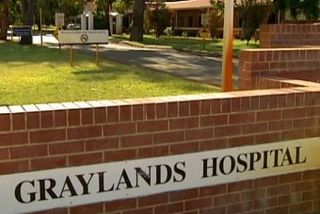
Graylands Hospital is Western Australia's largest mental health inpatient facility, and the only public stand-alone psychiatric teaching hospital. It is located on a 10-hectare (25-acre) site in Mount Claremont, in a suburb formerly known as Graylands, after which the hospital was named. The hospital has 178 beds, including 30 beds in the Frankland Centre, and 320 nurses on staff.

Bloomfield Hospital is a heritage-listed former psychiatric hospital at Forest Road, Orange, City of Orange, New South Wales, Australia. It was designed by Walter Liberty Vernon and George McRae and built from 1923 to 1931. It is also known as Orange Mental Hospital. The property is owned by Orange Ex-services Club. It was added to the New South Wales State Heritage Register on 10 March 2006.



















